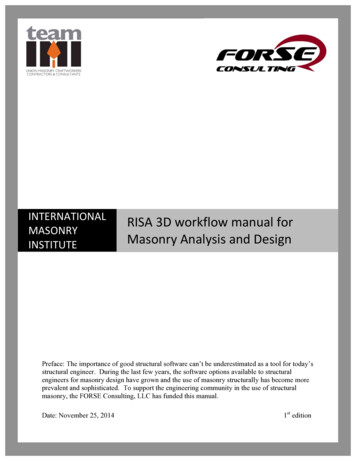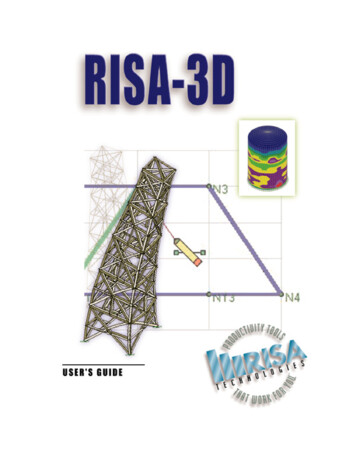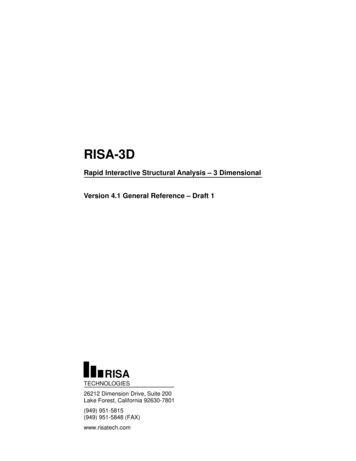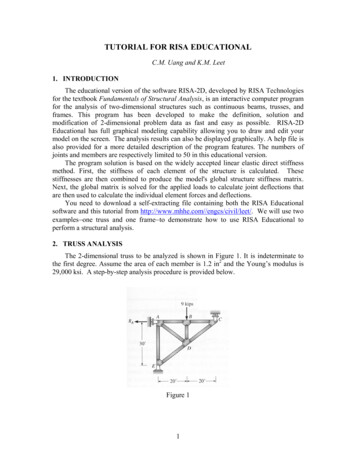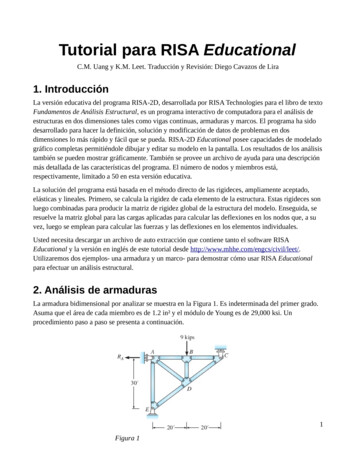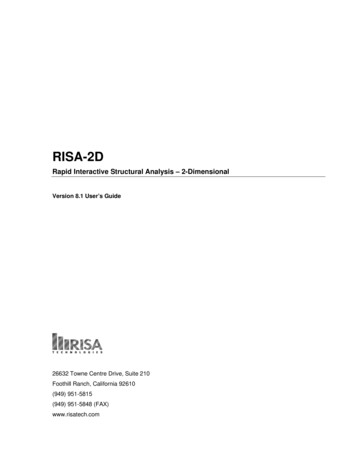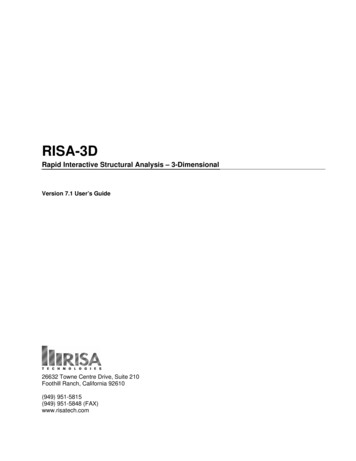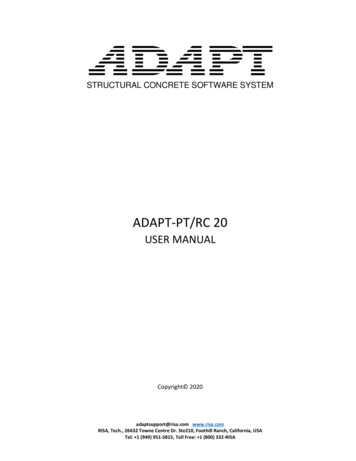
Transcription
STRUCTURAL CONCRETE SOFTWARE SYSTEMADAPT-PT/RC 20USER MANUALCopyright 2020adaptsupport@risa.com www.risa.comRISA, Tech., 26632 Towne Centre Dr. Ste210, Foothill Ranch, California, USATel: 1 (949) 951-5815, Toll Free: 1 (800) 332-RISA
LIST OF CONTENTS1Overview . 52Sign Convention . 113Workspace Overview . 1343.1The Main Program Window . 143.2Main Program Window Menu Items and Corresponding Tools . 153.2.1File Menu . 153.2.2Action Menu . 163.2.3View Menu . 163.2.4Options Menu . 163.2.5Window Menu . 173.2.6Help Menu . 173.3ADAPT-PT/RC Input screen . 183.4ADAPT PT/RC-Input Menu Items and Tools . 203.4.1File Menu . 203.4.2Project Menu . 203.4.3Geometry Menu . 203.4.4Loads Menu . 203.4.5Material Menu . 203.4.6Criteria Menu . 213.4.7Execute Menu . 213.4.8Tools Menu . 213.4.9Window Menu . 213.4.10Structure View Menu . 223.4.11View Tools Toolbar . 22Basic Program Operations . 254.1Start a New project . 254.2Open an Existing Project . 254.3Save Input Data . 254.4Save Input Data as Default. 264.5Select System of Units . 264.6Convert System of Units . 27i
4.75Program mode . 27Structural Modeling Overview . 295.15.2Project Information . 295.1.1Specify General Project Information . 295.1.2Specify Analysis and Design Options . 30Geometry. 345.2.1Specify Span Geometry . 345.2.1.1 Prismatic (Uniform) Spans . 355.2.1.2 Non-prismatic (non-uniform) spans . 395.35.45.2.2Specify Effective Flange Width . 425.2.3Specify Geometry of Drop Cap and/or Transverse Beam . 435.2.4Specify Geometry of a Drop Panel . 445.2.5Specify Support Geometry and Stiffness . 445.2.6Specify Support Boundary Conditions . 46Loads. 475.3.1Specify Dead, Live and Other loads . 475.3.2Specify Lateral Loads . 51Material . 525.4.1Specify Concrete Material . 525.4.2Specify Reinforcement Material . 525.4.2.1 Critical Section Outside the Reinforced Zone . 555.4.2.2 Minimum Reinforcement for Drift . 575.4.35.5Specify Post-Tensioning Material (PT mode only) . 58Criteria . 595.5.1Specify the Design Code . 595.5.2Specify Base Non-Prestressed Reinforcement . 605.5.3Specify Allowable Stresses (PT mode only) . 625.5.3.1 PT Crack Design Mode/Allowable Crack Width . 636ii5.5.4Specify Recommended Post-Tensioning Values (PT mode only) . 655.5.5Specify Calculation Options (PT mode only) . 655.5.6Specify Tendon Profile (PT mode only) . 665.5.7Specify Minimum Covers . 675.5.8Specify Minimum Bar Length . 685.5.9Specify Reinforcement Curtailment . 695.5.10Specify Load Combinations . 72Program execution Overview . 75
6.1PT Recycling Window Tabs . 766.2Design Indicator Box . 826.3Recycle Window Control Buttons . 846.4PT Selection Method. 866.4.1Force Selection Method . 876.4.2Tendon Selection Method . 876.4.2.1 Description of Features . 886.4.2.2 Description of Execution . 907View/Validate Results . 937.1ADAPT-BuilderSum Screen . 937.2ADAPT-BuilderSum Menu Items and Corresponding Tools . 947.37.2.1File Menu . 947.2.2Graphs Menu . 957.2.3Options Menu . 977.2.4Window Menu . 987.2.5Help Menu . 98PT Summary Report . 987.3.17.48Span Selection Toolbar . 99Export to DXF File. 107Reports Overview . 1098.1Report Generator Screen . 1098.2How to Create A Report . 1118.3Description of Report Sections . 1128.3.1Report Cover Page . 1128.3.2Table of Contents . 1138.3.3Concise Report . 1168.3.4Compact Report. 1248.3.4.1 Section 1- User Specified General Analysis and Design Parameters . 1248.3.4.2 Section 2: Input Geometry . 1268.3.4.3 Section 3: Input Applied Loading . 1318.3.4.4 Section 4: Calculated Section Properties . 1348.3.4.5 Section 5: Moments, Shears and Reactions . 1358.3.4.6 Section 6: Moments Reduced to Face of Support . 1388.3.4.7 Section 7: Selected Post-tensioning Forces and Tendon Profiles(PT mode only) . 1398.3.4.8 Section 8: Factored Moments and Reactions Envelope . 144iii
8.3.4.9 Section 9: Factored Lateral Moments Envelope . 1468.3.4.10 Section10: Mild Steel - No Redistribution . 1478.3.4.11 Section11: Mild Steel –Redistributed. 1498.3.4.12 Section 12: Shear Reinforcement. 1498.3.4.13 Section 13: Punching Shear Reinforcement . 1518.3.4.14 Section 14: Deflections . 1538.3.4.15 Section15: Friction, Elongation and Long-Term Stresses(PT mode only) . 1568.3.5Detailed Report . 1628.3.5.1 Section 21: Tendon Heights (PT mode only) . 1628.3.5.2 Section 22: Post-tensioning Balanced Loading (PT mode only) . 1628.3.5.3 Section 23: Detailed Moments. 1638.3.5.4 Section 24: Detailed Shears . 1648.3.5.5 Section 25: Factored Moments and Reactions . 1648.3.5.6 Section 26: Factored Lateral Moments . 1658.3.5.7 Section 27: Detailed Stresses (PT mode only) . 1668.3.5.8 Section 28: Required Post-tensioning (PT mode only) . 1678.3.5.9 Section 29: Detailed Rebar . 1678.3.5.10 Section 30: Punching Shear Reinforcement . 1688.3.5.11 Section 32: Detailed Friction and Long-Term Stress Losses(PT mode only) . 1698.3.5.12 Section 32: Unbalanced Moment Reinforcement . 1698.3.5.13 Section 34: Demand Moment and Moment Capacity . 1708.3.5.14 Section 35: Detailed Deflections . 1718.3.5.15 Section 36: Detailed Deflections Live Load . 1718.3.6Graphical Report . 1738.3.6.1 PT Force. 1738.3.6.2 PT-Profile . 1738.3.6.3 Deflection . 1748.3.6.4 Load Cases . 1748.3.6.5 Load Combination . 175iv
1OverviewADAPT-PT/RC is the state-of-the-art industry standard computer program for theanalysis and design of one-way or two-way conventional reinforced and post-tensionedfloor systems and beams. It is based on a single-story frame analysis with upper andlower columns. For two-way floor systems, the equivalent frame modeling of ACI can beused as an option. ADAPT-PT/RC is a Windows-based program. ADAPT-PT/RC treatsmulti-span continuous slab/plate and beam frames with or without cantilevers.ADAPT-PT/RC can be launched in a PT mode or RC mode for an applicable design. Savedfiles are interchangeable and can be opened in either mode once they are created. Thisdual functionality allows the user to easily navigate between reinforced concrete andpost-tensioned design and determine the most suitable and economical design. In addition to drop caps, ADAPT-PT/RC allows drop panels of different sizes tobe specified for different supports. Having a general frame analysis module forvariable sections, ADAPT-PT/RC can accurately model a wide range of dropcap/panel geometries. Also, special modeling features implemented in theprogram facilitate the modeling of local thickening in the slab along the line ofcolumns, generally referred to as slab bands. The slab/beam frame may be supported by walls, beams, or columns withdifferent connection details such as clamped, rotational, free, and more. ADAPT-PT/RC fully incorporates the equivalent frame option as described in ACI318 with no simplifications. In addition to the capability to handle theconventional configurations of column capitals and drop panels, the programallows the user to define a wide range of cross-sectional shapes. The softwareallows for the cross-section of the member to change along the length of a span,with abrupt steps, at the top, bottom, or both. Box girder bridge sections can be readily modeled as equivalent I-sections. Forpost-tensioned designs, ADAPT-PT/RC is well suited for a first design of boxgirder bridges, where an initial estimate of the amount and location ofprestressing is sought to achieve given stress levels and design criteria. For flanged beams, you can either select the software’s built-in effective widthcomputation, based on ACI-318 or EC2, or input a user-defined alternativeeffective width. The computations used are identical for RC and PT modes. The program recognizes and accounts for the difference between the effectivewidth in bending and pure compression. Using the geometry of the structural model input by the user, the programcalculates the self-weight loading of the structure for combination with other5
loads based on the selected concrete weight type. The user has the option tooverride the program defined material density. The calculated values of the selfweight are reported in the program’s output.6 The program includes a slab recommendation feature for one- and two-way slabsystems relative to recommended slab thicknesses without consideration ofdeflections per ACI318 for RC slab systems and recommendations given in“Post-Tensioned Buildings – Design and Construction,” Bijan O. Aalami for PTslab systems. All the three systems of units—the American customary units (ft-lb), SI units(mm, Newton), and the MKS units (m, kg)—can be executed from the same copyof the software. Also, all the different codes are integrated into a single version. You can either edit the factory-set or define your own default values for input ofdata, while retaining the option to revert to factory-set default values if you sochoose. Input to ADAPT-PT/RC is by means of a user-friendly, free-format, contextsensitive, full-screen input editor. The user may freely browse through, view,and modify the input prior to execution or saving of data. ADAPT-PT/RC includes an option for input of base (i.e. existing) reinforcementat any location along any span. The user can enter isolated or mesh flexuralreinforcement and/or shear stirrups as base rebar. This functionality is ideal forinvestigative models. The program gives the option to report design capacityand demand/capacity ratios relative to base or calculated reinforcement. For PTmode only, prestressed reinforcement is considered as base reinforcement.When shear reinforcement is modeled, the one-way shear reinforcement reportprovides design checks considering base stirrups. The program contains a new Rebar Curtailment input module. This module canbe invoked in post-processing of reinforcement output to customize and makereal time modifications to longitudinal reinforcement results. User-defined orcode-prescribed customization for longitudinal bar arrangements in beams andslabs for top and bottom reinforcement at cantilever, exterior and interiorconditions can be input to reflect conditions on final drawings and documents.This tool can be active for top and bottom bar conditions or turned off.Curtailment templates allows the user to save specific bar arrangementconfigurations for crossover use among multiple users. The tool applies to bothPT and RC modes. Reinforcement schedule output includes data transferred from the rebarcurtailment input including the bar mark, bar size, bar diameter, quantity, bar
length, shape codes, bar area and weight of bar. The schedule can be saved as.XLS format for ease of customization. The program includes an automatic rebar spacing check for minimum spacingbetween longitudinal bars. Design code minimum requirements are checked,and the program reports the number of layers required to fit the quantity ofbars. For PT designs, a library of tendon profiles allows the user to select a suitabletendon layout for each case. Common profiles included are the simple parabola,reversed parabola, simple parabola with straight portions over the supports,harped, strait and extended reversed parabola tendons. Low relaxation andstress-relieved strands, as well as unbonded and grouted post-tensioningsystems, are also supported by ADAPT-PT/RC. Uniform, line, partial, concentrated loads and moment, triangle, variable andtrapezoidal loads may be specified in practically unlimited numbers andvariations. Loading types are identical between PT and RC modes. ADAPT-PT/RC accounts for the shift in the location of the neutral axis of amember at changes in cross-section along the member length. Thus, theprogram can correctly handle steps along a member. ADAPT-PT/RC executes either automatically or interactively. This option isactive when in PT mode and does not apply to RC mode. In its automatic mode,based on user’s specifications, the software determines the required posttensioning and the associated reinforcement. In its interactive mode, theprogram displays the calculated required post-tensioning on the screen to theuser. You have the option to modify both the forces and the drapes during theprogram execution and recycle the selection until a satisfactory design isobtained, or you can input the conditions of an existing design. You can selectthe actual number and position of strands along a member. Also, in theinteractive mode, you can graphically view the distribution of stresses, tendonprofile and the required post-tensioning. This provides a good guide for you toachieve an optimum design. For PT mode only, stresses are computed and reported using the actual forcesand drapes selected. This feature distinguishes ADAPT-PT/RC from simpleprograms, where a single-pass analysis is performed, in which the option of theuser-initiated changes in post-tensioning are not reflected in the subsequentcalculations. ADAPT-PT/RC has a multi-pass processor. It updates all the designvalues based on changes made in the tendon profile and force before itconcludes its report of design values.7
8 For PT mode only, serviceability design of the slab/beam is achieved throughdetailed stress control. For both modes, the program carries outcomprehensive deflection calculations for both instantaneous and long-termdeflections. Where the cracking limits of concrete are exceeded, a crackedsection deflection estimate is carried out using an equivalent moment of inertia. A thorough strength analysis and design is conducted to determine anyreinforcement that may be necessary to meet the ultimate strength limitconditions. In PT mode, this calculated reinforcement is in addition to theprestressing steel. For RC mode, the calculated reinforcement is the totalamount of reinforcement necessary to meet the demand actions for the entirestrip width. The user specifies allocation percentages (%) for column andmiddle strips which result in reported reinforcement for each strip type. Other code requirements for reinforcement, such as the minimum requirementsof the building codes, are also checked and a listing of the reinforcement basedon different criteria is reported. The program recognizes mixed/hybrid models that include design sections thatare not intersected by post-tensioning. The program can determine properamounts of reinforcement relative to differentiating requirements of RC and PTdesign sections. Bar sizes and lengths are selected and reported both in a graphical andtabulator format, ready to be entered on the structural drawings. Base (user-defined) reinforcement can be modeled for flexural reinforcement inbeams and slabs and for shear reinforcement for beams and one-way slabs. Theprogram considers base reinforcement in determining required reinforcementnecessary to meet minimum and strength level demand actions. The punching shear option checks the adequacy of the column caps as well asthe immediate slab/drop panel region beyond the cap and provides punchingshear reinforcements if required. For one-way slabs and beams, a one-wayshear analysis is carried out. Shear reinforcement is calculated, and the stirruprequirements are given. For PT designs, ADAPT-PT/RC can handle both the effective force and thevariable force methods. For PT mode the variable force method ADAPT-PT/RC calculates the change oftendon force along its length and can use the force at each location along thelength of a member to perform a code check for that location. In addition to theimmediate losses due to friction, and seating loss, and at user’s option, thesoftware accounts for the long-term stress losses along the length of the
structure. Since long-term losses for grouted tendons are functions of localstrain, an iterative non-linear capability is built into the program. The nonlinearity in the solution is with increments of load. For PT mode when the effective force method is used, the force along eachtendon is assumed constant. In this case, the design is based on a non-iterativelinear solution in terms of the effective force. For PT mode another execution option is the computation only of immediatelosses resulting from the friction and seating of strands. The long-term losses inprestressing are then affected through a user defined lump sum stress loss. The geometry of the structural model can be viewed on the screen in a threedimensional space. The capability to rotate, pan, zoom and view the modelallows the user to examine the structure in detail prior to the execution of theprogram. Errors in data entry or modeling are readily detected when user’sinput is displayed on the computer screen. Hard copies of the graphical displayof the structural model can be readily obtained. ADAPT-PT/RC uses the detailed scheme throughout its operation. This scheme isbased on 1/20th point values along each span. However, to retain the simplicityof presentation of the report, in addition to the optional 1/20th point reports, asummary of the solution is compiled for the left, center and right of each span. In addition to graphical reports, the outcome of the analysis and design iscomposed into a clear text file that can be viewed, edited, and printed by you.The text file can be produced in Word (.RTF) or as an Excel (.XLS) file. Thecontent and extent of the report can be controlled by you through a userfriendly menu. It is also possible to generate a one-page graphical summary report that extractsand incorporates all important design information in an easy-to-interpretformat. The report may also be exported as a DXF file for incorporation intoconstruction documents. The DXF feature includes options to customize thename and scale of the drawing file. For PT mode, up to three distinct tendonprofiles can be shown, with respect to the datum line or the soffit of thestructure if they differ. Tendon heights can be exported in the format of thetendon CGS heights or tendon support heights. Further details of exporting toDXF include the customization of visualization of the tendon profile, anchorpoints and control points, as well displaying information at 20th interval pointsor user-specified intervals. The visualization of longitudinal and one-way shearreinforcement can also be generated through the DXF import option. Thisapplies to both RC and PT modes of operation. The user has the option tooverlay the reinforcement graphical output in one drawing or create separatedrawings for each.9
10 The graphical display option of ADAPT-PT/RC provides a vivid exposition of thedistribution of calculated values along the entire structure or for its selectedmembers. The displays relative to RC and PT mode include moments, shears,deflections, and reinforcement required/provided.
RISA, Tech., 26632 Towne Centre Dr. Ste210, Foothill Ranch, California, USA Tel: 1 (949) 951-5815, Toll Free: 1 (800) 332-RISA . The software allows for the cross-section of the member to change along the length of a span, with abrupt steps, at the top, bottom, or both.
